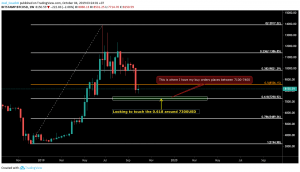One who understands this market looks down at it and says, “We haven’t even done a 0.618 retracement, basically, from the bottom at $3100 to just below $14, 000.”

Some may call it a bear market, some may call it a bull market
The 0.618 retracement is around $7,300, which is why in the last article, I’ve mentioned this zone. Technically, some may call it a bear market and some may still call this market a bull market.
I wouldn’t flip my bias until we go under $7,300 and stay there without any bounce.
I think if we went even lower than $7,300, that would result in a very short term movement to bounce. Consequently, the price would recover very quickly, and go above $7,300 and then very likely would start a new uptrend.
Here is one funny thing about multiple time frame analysis. When you look at the charts, you never really know until hindsight 100%, but that being said some factors make your probability of being correct higher.
In trading, we look for confluence based on experience, indicators, price action and volume, amongst many other things.
When we break $14K, I would suggest, some other alts will start to pump
If Bitcoin (BTC) goes into a bear market, we won’t see retail investors coming to the market until large institutions start making it very easy for new users to buy crypto as well as large organizations making it mainstream. I also believe that most of the alt market will slowly wither up and die. Meaning, potentially more than 90% in the next few years would be sucked out of the market, and of course, the several that are outright scams, because they didn’t do what their whitepaper said or they just didn’t live up to what they promised.
We need Bitcoin (BTC) to break an all-time high for people to get excited, some other high-cap alts like Ripple (XRP), Bitcoin Cash (BCH), Ethereum (ETH), even Stellar (XLM) can rebound, but it’s all dependent on Bitcoin.
When Bitcoin (BTC) reaches the yearly high of $14K, that’s where you should be looking at altcoins for some real growth.
We won’t see the whole market to rise until Bitcoin (BTC) breaks its all-time high and people in the retail sector look at it and go, “Oh, it wasn’t a bubble, it wasn’t a scam”. That will likely coincide with the federal interest rate cuts, inverted yield curve and mass quantitative easing. Which by the way is now $271 bn – an additional $71 bn more from the last weeks article.
Like we saw in 2008, it took a little bit of time to showcase all the negative consequences. When we see those, people are going to react swiftly, and many will see Bitcoin (BTC) as a safe haven, something they didn’t have in 2008. You might call this type of event Bitcoin’s true test.
You have to understand the mindset of the institutional smart money investors
Bakkt is doing exactly what we thought it was going to do. If you read my tweets about Bakkt you would know that I’ve fully expected that after Bakkt launched we were going to see a dump.
Most people were rather thinking Bitcoin (BTC) was going to pump. I was very adamant that we were going to see a dump, because Bakkt was going to underperform what retail investors expected.
It has epically done that. We’ve seen what everyone thought, namely that those institutions would come – and they haven’t.
But you have to understand the mindset of those institutional guys and why they haven’t joined. They have a lot of money that they don’t need to rush into Bitcoin. It’s like, “We don’t need to go there right now, what’s the rush”.
So, what are guys from Bakkt going to do? The same as the CME, they will go slowly and test the waters, see how the instruments perform and make sure everything’s working properly. After that, they’ll start adding a little bit more. And we already have seen that as they most recently had 5 mln USD worth of BTC from less than 100,000 USD the first few days.
It was in early September this year that the CME doubled the amount of futures contracts for Bitcoin. This happened after it was around for over a year, but there was growth nonetheless.
Bakkt has physically-backed Bitcoin futures. Meaning the company is backed with real Bitcoin unlike the CME who are using CFDs. This is different and may also mean that it is in their best interest to see Bitcoin not free fall as often as it has seemingly done recently in the long term.
Bakkt didn’t even reach one-tenth of the Bitcoin volume it has insured
I think for a lot of people only 4 Bitcoins in play right after the launch was surprising, and retail investors were shocked and likely many shorted. As the saying goes, “Buy the rumour, sell the news”.
Generally, institutions like to see what’s going to happen with new instruments and products when they come out. They like to start slowly, and then, when they see everything is working, the ball is rolling – the same thing happened to the CME – they slowly start to gain confidence in those instruments, and now we see trading activity.
Even though Bakkt launched with the backing of the Intercontinental exchange, it is still something very new, and people had been waiting for a long time. It has launched short of many expectations because guys from Bakkt have 150 mln in insurance and currently only 5 mln USD worth of BTC in custody.
The retail sector thought it would happen overnight, and it didn’t. It comes much slower than what they want. Most retail investors want to get rich quick and make money fast, but old-money institutional players, they can make 2% to 10% a year and still be very wealthy!
Are nextgen altcoins different?
The nextgen altcoins are mostly projects that have been building but have not yet been released. You might have heard of several of them like Solana, Nervos, or Polkadot, which we know from the Parity freeze by a developer causing $160 mln in Ethereum to be frozen.
Many of us are familiar with Nervous, Mobile Coin, Cadena, and Handshake. FileCoin and Dfinity are two massive ones as well as Telegram’s Gram Token.
Several of those projects are very highly rated, and many of them only needed private sales. They didn’t need to go and get retail investors, which shows some strength. These are projects that are working to solve problems.
I don’t know for sure if all of them are going to be successful. In fact I still think several of them will fail. If we look, for example, at Cosmos, it’s on the same echelon as a lot of those coins that Coinbase is looking at right now – like FileCoin and Dfinity.
We know that this project has built something useful like interoperability between blockchains. They actually came to market with something that other altcoin projects didn’t have. After years of people waiting, and their investors enjoyed a 50X return.
A lot of guys that I know in the bigger VCs, in New York, for example, have invested in Dfinity. Many also invested in FileCoin, Mobile coin, and Polkadot.
Cadena, Handshake and Solano, they may all do very well, and that’s the reason why they are on Coinbase’s list. Coinbase really does due diligence. It’s not easy to get on Coinbase. It’s not easy to get into Coinbase custody – I know from actual experience working with teams, this indeed is a fact..
What it all comes down to is that if you haven’t heard of those new coins, you should be doing your own research to learn who they are and what they do.
Now, are nextgen altcoins different? Maybe. They might be different in a way that they are going to potentially add more value to the ecosystem than some of the other projects from the past.
Just because these coins come out and they have a lot of money backing them, doesn’t mean that users are going to use them.
People start using a cryptocurrency when it solves a problem, when it is making something easier or faster, saves us time and brings great benefit to our lives. When it’s its easy to have crypto on your phone, not easy to lose by accident or send it to an incorrect address without recovery, when it becomes simple for the average user, this is when you’re going to see the eureka moment from those people, and they are going to go, “Wow, this tech is awesome!”
To conclude, the only thing that’s holding back the altcoin industry in general right now is that projects haven’t yet figured out the easier, faster, better conundrum. I think that’s coming potentially with the wave of nextgen altcoins that have been working with a strong foundation of funding, a great team of people and a proper vision and use case behind the project.
In the grand scheme of things, what I am looking for is seeing if projects deliver what they said they would. Most people understand ICOs and altcoins as an investment vehicle that failed everybody and quite frankly they are right for 98% of these projects currently. Let’s see if the new generation of altcoins will complete what they’ve put into their whitepapers and if they actually reach their goals. If they do, that could be the very echelon to push out crappy projects and start inviting the projects into the space that solve real problems, and bring forth adoption of cryptocurrencies.
FAQ
What happens if BTC goes into bear market?
If Bitcoin (BTC) goes into a bear market, we won’t see retail investors coming to the market until large institutions start making it very easy for new users to buy crypto as well as large organizations making it mainstream.
